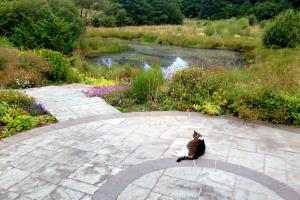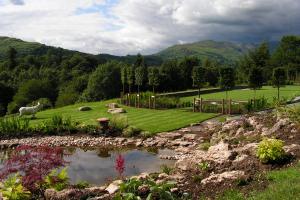What to consider when designing a natural pond:
Location-It is important to consider the location of the pond for both practical and aesthetic reasons. For aesthetic reasons you may want to consider the view from the house, seating areas and the reflection of light from the sun. For practical reasons it is important to consider the ground terrain, proximity to trees and sunlight is also important.
Shape-Most informal and natural ponds are a free form shape, this makes it both easier to excavate and line. However a wildlife pond can still be achieved in a more geometric style pond with areas of gently sloped edges and appropriate planting.
Size and context-The pond should harmonise with the scale of the surroundings. It is important to make sure that there is enough space to walk around some areas of it close to the waters edge or to sit and enjoy it. Some areas can be left where wildlife can thrive without interference. A wildlife pond is beneficial to the environment no matter what size it is-large or small.
Existing ground and soil type-, whether it is clay, solid rock or soft wet ground. A test pit at the beginning of the design is a good idea. Clay soils are generally easy to dig when they are moist. Solid rock can present a problem and require large machinery. It may be easier to avoid such areas but it is difficult especially in Cumbria-often the boulder clays have large fragments of rock and boulders that can be moved but large solid bed rock will pose a problem. Sometimes a natural rock out crop can look good jutting into a pond. The trick is to bring the liner inside it and hide it with other rocks. Soft wet ground is suitable for an unlined pond or bog garden but is sometimes difficult for machinery to dig. Lined ponds should not be located in these areas and are better placed on higher ground above.
Drainage- It is best to locate a pond higher up and place field drains around the pond to direct storm water away from it. An overflow system should be installed to tap into the drainage system.
Aeration- All ponds should have some form of aeration whether it is a stream or recirculated waterfall flowing into it or a fountain, the water should circulate around to create oxygen. Some aquatic plants can also help to aerate the water
Sunlight-Try to locate the pond so that the reflective qualities of the sun can most be enjoyed. The best effects are when the sun shines from behind you lighting up the further side of the pond as opposed to creating a strong glare.
Existing trees-As a general rule ponds should not be positioned near trees-however this does depend on the size of the pond and the tree coverage. The issues relate to shade and leaf fall and both can effect the oxygen levels and health of the pond and the water may become black.
Safety-Generally an edge with a gradient of 1:6 is sufficient for people to be able to walk out of. If there are small children around they should be supervised in the garden unless a fence and gate system or a natural physical barrier is created.




